
We recommend you visit the interactive version. The text to the right is provided for printing purposes.
|
For many
of us, it may be hard to imagine that if we went back far enough in
time—more than 55 million years, when the first primates are thought to
have lived—that our great-a-million-times-over-grandparent was a
mouse-sized creature weighing just over an ounce. Yet just as assuredly as if
your parents hadn't lived, you wouldn't exist if that putative
ancestor hadn't lived.
So, want
to meet that very distant relative of yours? Here, we'll lead you back
through key stages in your primate heritage, as revealed in the fossil record,
till you come face-to-face with your great-to-the-nth-degree-grandparent.
Nervous?—Peter Tyson
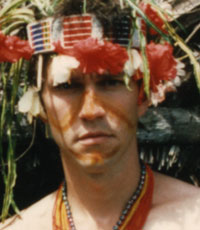

|
|
Homo
sapiens
Present
day
This is a
modern human. Actually, it's me, the author, about 20 years ago.
Don't ask what I'm doing. Instead, imagine your own picture here
rather than mine. This is about your
ancestors, after all (well, mine too).
Can you
"see" yourself in the frame? Okay, now let's just say for the
sake of argument that you were born in the year 2000 and that a generation is
25 years. (It will make the math a whole lot easier.) Ready? First read some
details about yourself below, then move on to the first of your ancestors shown here.
Your
Profile
You are a
bipedal primate. Your species, Homo sapiens, also known as modern humans, arose in Africa about 200,000
years ago. Your kind's most defining characteristic is its large brain.
That three-pound universe inside your skull enables you, among other things, to
speak a language, reason abstractly, and contemplate whatever it is you like to
contemplate.
|
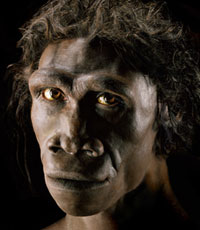

|
|
Homo
erectus
1.6
million years ago
Okay,
rewind the clock 1,600,000 years. You've gone back 64,000 generations in
your family history. Here's what your ancestor of around this time might
have looked like.
Your
Ancestor's Profile
Your
genus, Homo, arose about 2.4 million
years ago. Its appearance was marked by a significant, though not huge,
increase in brain size from earlier primates. H. erectus dates to 1.9 million years ago, and its best-known
skeleton, the so-called Nariokotome boy, is about 1.6 million years old. H.
erectus is the first member of your line to
show fully modern body size and proportions. Had he lived longer, for instance,
the Nariokotome boy would have grown up to be about six feet tall.
|
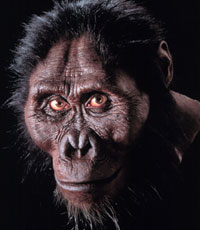

|
|
Australopithecus
3.2
million years ago
Now,
double that rewind. You're now 128,000 generations of your family into
the past. Meet your great-whatever-grandfather. This isn't just a thought
experiment—you did have a male
forebear in this period, and he might have resembled this individual.
Your
Ancestor's Profile
Australopiths
are the earliest undisputed members of the human family. Their most standout
advance over their predecessors was the ability to stand on two legs. Their
brains were still small, however, about the size of a modern
chimpanzee's. Lucy, the most famous australopith fossil, designated Australopithecus
afarensis, dates to 3.6 to 2.9 million
years ago. She would have weighed between about 65 and 110 pounds, similar to a
chimp.
|
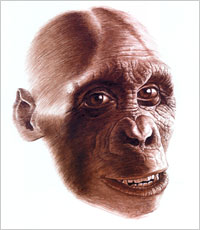

|
|
Dryopithecus
9.5
million years ago
Now
we'll take a great leap back. Your progenitor—your direct ancestor, remember, removed only by oodles of
time—is about the size of a chimp and may have borne a likeness to this
fellow. Look like anyone in your family?
Your
Ancestor's Profile
We've
now moved out of hominids and into ape-like mammals. Dryopithecus was an advanced ape. The best-known skeleton of this
genus, uncovered in Spain, is 9.5 million years old. Experts estimate that when
it was alive, that individual had a body mass of about 75 pounds, again similar
to a living chimp. And like a chimp, it would have hung from its powerful
forelimbs while going about its life in the trees.
|
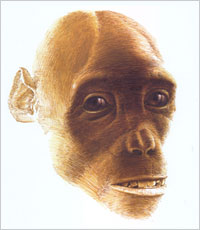

|
|
Proconsul
20
million years ago
Hang on,
we're zipping back through 800,000 generations of your line—a long
way down your family tree. Back then your primogenitor was more like a monkey
than a chimp, no offense.
Your
Ancestor's Profile
Proconsul is the most primitive ape that is well-known from a fossil skeleton.
It lived in Africa about 20 million years ago. Like modern apes, it lacked a
tail, but it would have been monkeylike in behavior, moving around in the trees
on all four limbs. It weighed between 37 and 110 pounds. (There are different
species that weighed different amounts. The bigger ones would have approached a
modern chimp in size.)
|
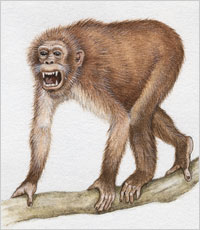

|
|
Aegyptopithecus
30
million years ago
Ever seen
a howler monkey? That's what your extended family member would have
resembled roughly halfway back to the dinosaurs, temporally speaking.
Your
Ancestor's Profile
Aegyptopithecus—the name honors Egypt, where its fossil remains were
found—was a primitive anthropoid, the group that includes monkeys, apes,
and us. It would have weighed about 15 pounds, roughly the same as a modern
howler monkey, and its behavior would have been similar to that of living
monkeys.
|
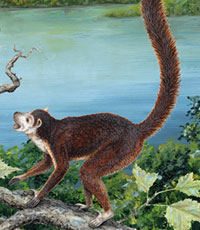

|
|
Notharctus
45
million years ago
Your
great-times-a-very-high-number-
grandparent would have resembled a modern-day
lemur. Cute, eh?
Your
Ancestor's Profile
Notharctus would have been similar to living prosimians like lemurs.
(A prosimian is a lower primate.) It would have weighed perhaps two to four pounds, which is
about the same as a golden bamboo lemur. It lived in western North America about 45
million years ago.
|
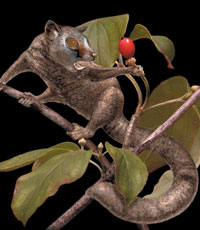

|
|
Carpolestes
55
million years ago
We're
getting close to your ultimate primate grandparents. But first, meet one of
your most primordial ancestors, who may have looked like this mole-sized
critter.
Your
Ancestor's Profile
Carpolestes is a very early primate, but it has features that set it
apart from the most primitive primates of all, including a nail rather than a
claw on its big toe. Its closest living analogue would be a woolly opossum from
South America. The skeleton this image is based on turned up in Wyoming. When
alive, the animal would have weighed about three-and-a-half ounces.
|
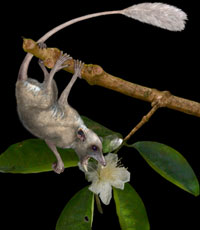

|
|
Dryomomys
55 million
years ago
We've
now arrived at one of your very earliest precursors, Dryomomys. Something like this creature begot something that begot
something that, after that eternity of time, begot you—only time separates the two of you. Now, imagine if you could erase
that intervening eternity for a moment and meet your hugely distant forebear.
At a smidgen bigger than a mouse, this nearly eldest of all your elders would
fit snugly in the palm of your hand.
Your
Ancestor's Profile
Dryomomys is the most primitive primate known from good fossil
material. (The first known primate, Purgatorius, dating back as far as 65 million years ago, is known only
from isolated teeth and jaw fragments.) The animal most like Dryomomys today is a wee being called the pen-tailed tree shrew. Dryomomys would have weighed about 1.3 ounces, roughly akin to that
of the smallest living primates, the mouse lemurs of Madagascar. Like its
cousin, the roughly contemporary but more advanced Carpolestes, the Dryomomys skeleton
that the reconstruction is based on was unearthed in Wyoming.
|
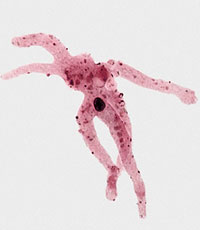

|
|
The
Start of You
4
billion years ago
Forgive
us, but we thought that since you've come this far you might like to meet
your true ultimate ancestor on Earth.
That beyond-imaginably-distant relative may have appeared something like this
single-celled protozoan. See any resemblance?
Your
Ancestor's Profile
Paleontologists
believe the first living cell somehow came to life about four billion years
ago. (Explaining that "somehow" is the holy grail of
origins-of-life researchers.) Beyond that humble organism, whatever it was,
your heritage on this planet, sorry to say, dies out. Or, if it makes you feel
better, was yet to be born. But that's 160 million generations of your
family in the past, and who can count that high anyway?

|
Note: Most everything known about our primate heritage remains
fragmentary and hotly debated among scholars, more so the farther back in time
one travels in the fossil record. The eight fossil primates presented here are
often-cited examples of key stages in primate evolution, and their artistic
reconstructions are based on careful study of the paleontological evidence.
Thanks to Mary T. Silcox of the University of Winnipeg for supplying details on
each fossil primate.
|
|












